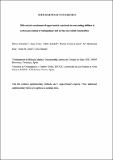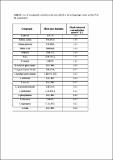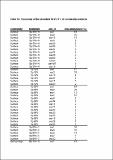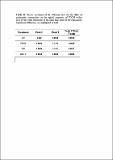Por favor, use este identificador para citar o enlazar a este item:
http://hdl.handle.net/10261/227285COMPARTIR / EXPORTAR:
 SHARE SHARE
 CORE
BASE CORE
BASE
|
|
| Visualizar otros formatos: MARC | Dublin Core | RDF | ORE | MODS | METS | DIDL | DATACITE | |

| Título: | Differential recruitment of opportunistic taxa leads to contrasting abilities in carbon processing by bathypelagic and surface microbial communities |
Autor: | Sebastián, Marta CSIC ORCID; Forn, Irene CSIC ORCID ; Auladell Martin, Adria CSIC ORCID ; Gómez-Letona, Markel; Sala, M. Montserrat CSIC ORCID ; Gasol, Josep M. CSIC ORCID ; Marrasé, Cèlia CSIC ORCID | Fecha de publicación: | ene-2021 | Editor: | Society for Applied Microbiology | Citación: | Environmental Microbiology 23(1): 190-206 (2021) | Resumen: | Different factors affect the way dissolved organic matter (DOM) is processed in the ocean water column, including environmental conditions and the functional capabilities of the communities. Recent studies have shown that bathypelagic prokaryotes are metabolically flexible, but whether this versatility translates into a higher ability to process DOM has been barely explored. Here we performed a multifactorial transplant experiment to compare the growth, activity and changes in DOM quality in surface and bathypelagic waters inoculated with either surface or bathypelagic prokaryotic communities. The effect of nutrient additions to surface waters was also explored. Despite no differences in the cell abundance of surface and deep ocean prokaryotes were observed in any of the treatments, in surface waters with nutrients the heterotrophic production of surface prokaryotes rapidly decreased. Conversely, bathypelagic communities displayed a sustained production throughout the experiment. Incubations with surface prokaryotes always led to a significant accumulation of recalcitrant compounds, which did not occur with bathypelagic prokaryotes, suggesting they have a higher ability to process DOM. These contrasting abilities could be explained by the recruitment of a comparatively larger number of opportunistic taxa within the bathypelagic assemblages, which likely resulted in a broader community capability of substrate utilization | Descripción: | 17 pages, 5 figures, 2 tables, supporting information https://doi.org/10.1111/1462-2920.15292.-- This is the pre-peer reviewed version of the following article: Marta Sebastián, Irene Forn, Adrià Auladell, Markel Gómez‐Letona, M. Montserrat Sala, Josep M. Gasol, Cèlia Marrasé Environmental Microbiology 23(1): 190-206 (2021), which has been published in final form at 10.1111/1462-2920.15292. This article may be used for non-commercial purposes in accordance with Wiley Terms and Conditions for Use of Self-Archived Versions | Versión del editor: | https://doi.org/10.1111/1462-2920.15292 | URI: | http://hdl.handle.net/10261/227285 | DOI: | 10.1111/1462-2920.15292 | ISSN: | 1462-2912 | E-ISSN: | 1462-2920 |
| Aparece en las colecciones: | (ICM) Artículos |
Ficheros en este ítem:
| Fichero | Descripción | Tamaño | Formato | |
|---|---|---|---|---|
| Sebastian_et_al_2021_preprint.pdf | 959,62 kB | Adobe PDF |  Visualizar/Abrir | |
| Sebastian_et_al_2021_suppl_1.pdf | 1,97 MB | Adobe PDF |  Visualizar/Abrir | |
| Sebastian_et_al_2021_table_suppl_1.pdf | 182,17 kB | Adobe PDF |  Visualizar/Abrir | |
| Sebastian_et_al_2021_table_suppl_2.pdf | 201,39 kB | Adobe PDF |  Visualizar/Abrir | |
| Sebastian_et_al_2021_table_suppl_3.pdf | 180,51 kB | Adobe PDF |  Visualizar/Abrir | |
| EMI_15292_asv_table_forreview.txt | 252,05 kB | Text | Visualizar/Abrir | |
| EMI_15292_metadata_table_forreview.txt | 1,27 kB | Text | Visualizar/Abrir | |
| EMI_15292_taxonomy_table_forreview.txt | 150,4 kB | Text | Visualizar/Abrir |
CORE Recommender
SCOPUSTM
Citations
7
checked on 21-abr-2024
WEB OF SCIENCETM
Citations
6
checked on 25-feb-2024
Page view(s)
137
checked on 24-abr-2024
Download(s)
432
checked on 24-abr-2024
Google ScholarTM
Check
Altmetric
Altmetric
NOTA: Los ítems de Digital.CSIC están protegidos por copyright, con todos los derechos reservados, a menos que se indique lo contrario.
